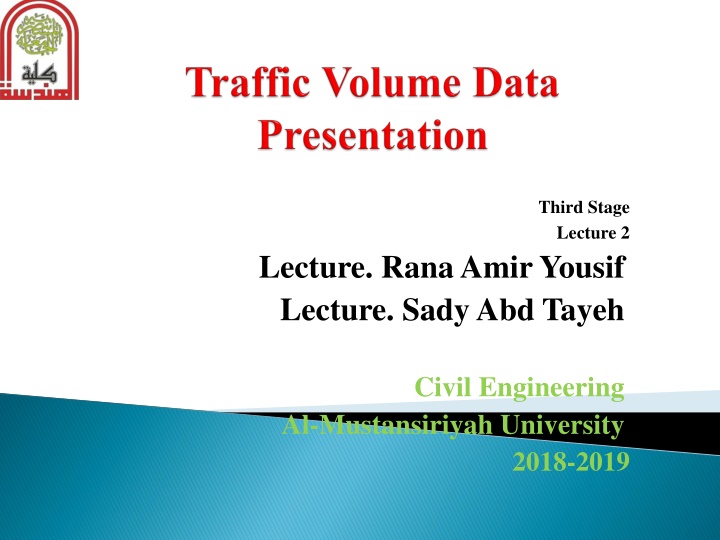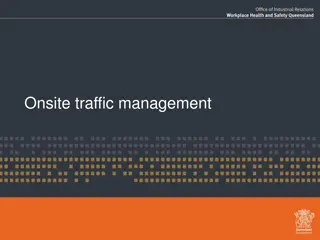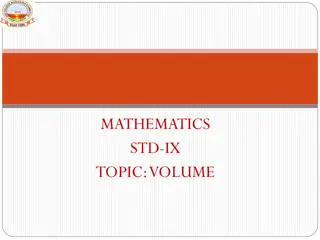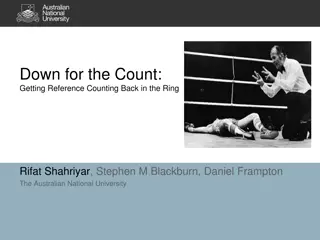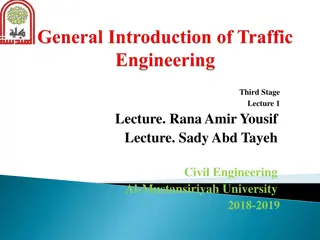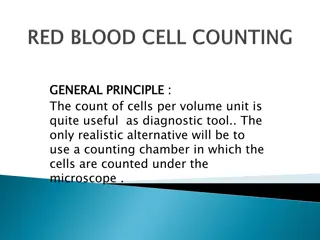Traffic Volume Counting Methods and Analysis in Civil Engineering
Traffic volume counting in civil engineering involves various methods like traffic flow maps, intersection summary sheets, time-based direction charts, and summary tables. The collected data helps in analyzing peak periods, special events impact, and determining road capacity based on vehicle classes. Understanding different vehicle characteristics and converting them to Passenger Car Units (PCU) is crucial for accurate traffic volume estimation.
Download Presentation

Please find below an Image/Link to download the presentation.
The content on the website is provided AS IS for your information and personal use only. It may not be sold, licensed, or shared on other websites without obtaining consent from the author.If you encounter any issues during the download, it is possible that the publisher has removed the file from their server.
You are allowed to download the files provided on this website for personal or commercial use, subject to the condition that they are used lawfully. All files are the property of their respective owners.
The content on the website is provided AS IS for your information and personal use only. It may not be sold, licensed, or shared on other websites without obtaining consent from the author.
E N D
Presentation Transcript
Third Stage Lecture 2 Lecture. Rana Amir Yousif Lecture. SadyAbd Tayeh Civil Engineering Al-Mustansiriyah University 2018-2019
24 hour counts normally cover any 24 period. 16 hour counts usually from 6 a.m. to 10 p.m. 12 hour counts usually from 7 a.m. to 7 p.m. Peak period counts usually from 7 to 9 a.m. and 4 to 6 p.m. Weekend counts covering the period from noon (6 p.m.) on Friday to noon (or 6 a.m.) on Sunday for the weekends days. 1. 2. 3. 4. 5. Special events should be avoided in counting unless the purpose of the counts is to obtain data concerning these unusual conditions. Special events ( holidays, sports, etc.). Abnormal weather conditions. Temporary closure of streets affecting the volume pattern. Transit or trucking strikes. a) b) c) d)
The data collected from traffic volume counts may be presented in one of several ways, depending on the type of count conducted and primary use of data. Traffic Flow Maps:- show traffic volumes on individual routs. The volume of traffic on each route is represented by width of a bond, which is drawn in proportion to the traffic volume it represents. When the flow is different on opposite advisable to provide a separate band for each direction. directions, it is
Intersection Summary Sheets: graphic representation of all volume and directions of all traffic movements through the intersection. These volume may be ADT or PHV depending on the use of data.
Time Based Direction Charts: these charts show the hourly, daily. Monthly or annual variation in traffic volume. Each volume is percentage of the average volume.
Summary Table: which gives a summary of traffic volume data such as PHV, VC, andADT in tabular form.
The different vehicle classes have a wide range of static characteristics such as length, width, etc. and dynamic characteristics such as speed, acceleration, etc. it is rather difficult to estimate the traffic volume and capacity of roadway under mixed traffic flow, unless the different vehicles classes are converted to one common standard vehicle unit. It is common to consider the passenger car unit (PCU) PCU 1 Buss( 24 passenger) 1.25 1 Buss(>24 passenger) 1 Truck 1 motorcycle 1 Bicycle 1 Buss( 24 passenger) Light good vehicle 1-1.25 Heavy vehicle Pcu 2-3 2 0.33 0.25 1.25 3
Solution: No. Passenger cars No. of busses (25 passenger) No. heavy vehicle No. of motorcycle Total equivalent passenger car = 4250*1+ 425*2.5+3570*3+255*0.33 Total equivalent passenger car = 4250+1062.5+10710+84.15 = 8500* (50/100) = 4250 = 8500* (05/100) = 425 = 8500* (42/100) = 4570 = 8500* (03/100) = 255 = 16107
Expansion factors, used to adjust periodic counts, are determined either from continues count or from control count stations. 1. Hourly expansion factor (HEF)=(total volume for 24 hr period)/ volume for particular hour These factors are used to expand counts of durations shorter than 24 hr to 24 hr volume, by multiplying the hourly volume for each hour during the count period by HEF, for that hour. 2. Daily expansion factor (DEF)=(average total volume for week)/ average volume for particular day These factors are used to determine weekly volumes from counts of 24 hr duration by multiplying the 24-hr volume by DEF. 3. Monthly expansion factor (MEF)=( AADT)/ ADT for particular month The AADT for a given year may be obtained from ADT for a given month by multiplying the volume by MEF.
Hour 6:00-7:00 a.m. 7:00-8:00 a.m. 8:00-9:00 a.m. 9:00-10:00 a.m. 10:00-11:00 a.m. 722 11:00-12:00 a.m. 667 12:00-1:00 p.m. 1:00-2:00 p.m. 2:00-3:00 p.m. 3:00-4:00 p.m. 4:00-5:00 p.m. 5:00-6:00 p.m. Total Daily Volume = 12350 Volume 294 426 560 657 HEF 42 29 22.05 18.8 17.1 18.52 18.71 16.71 14.84 14.77 12.85 13.85 Hour 6:00-7:00 p.m. 7:00-8:00 p.m. 8:00-9:00 p.m. 9:00-10:00 p.m. 10:00-11:00 p.m. 11:00-12:00 p.m. 12:00-1:00 a.m. 1:00-2:00 a.m. 2:00-3:00 a.m. 3:00-4:00 a.m. 4:00-5:00 a.m. 5:00-6:00 a.m. Volume 743 706 606 489 396 360 241 150 100 90 86 137 HEF 16.62 17.49 20.38 25.26 31.19 34.31 51.24 82.33 123.5 137.22 143.6 90 660 739 832 836 961 892
Day of Week Sunday Monday Tuesday Wednesday Thursday Friday Saturday Total weekly volume= 75122 Volume 7895 10714 9722 11413 10714 13125 11539 DEF 9.515 7.012 7.727 6.582 7.012 5.724 6.510
Month Jan. Feb. Mar. Apr. May June July .Aug Sept. Total yearly volume = 28450 Mean average daily volume = 2370 ADT 1350 1200 1450 1600 1700 2500 4100 4550 3750 MEF 1.756 1.975 1.635 1.481 1.394 0.948 0.578 0.521 0.632 Month Oct. Nov. Dec. ADT 2500 2000 1750 MEF 0.948 1.185 1.354
Hour 7:00-8:00 a.m. Volume 400 535 650 710 650 8:00-9:00 a.m. 9:00-10:00 a.m. 10:00-11:00 a.m. 11:00-12:00 a.m.
Estimate the 24 hr volume for Tuesday using factors in Table (1): =(400*29+535*22.05+650*18.8+710*17.1+650*18.52)/5 = 11959 vpd Adjust the 24 hr volume for Tuesday to an average for the week using the factors given in Table (2): Total 7-day volume = (11559*7.727)/7 =13201 vpd Since the data were collected in May , use the factor shown for May in Table (3) to obtainAADT: AADT= 1320*1.394 = 18402
The design should include the expected future traffic for period range (15-20) years. F = (1+growth rate)^no. of years F = (1+i)^n Future = present * F Future = present * (1+i)^n Where: N: analysis period ( design and construction life) Present: current volume i: growth factor rate (3-12)%Special functions include decimal in
Future = present * (1+growth rate)^no. of years Future = 3000 * (1+0.08)^25 = 20400 veh/day DHV= 20400 * 0.12 * 0.55 = 1346 veh/day
